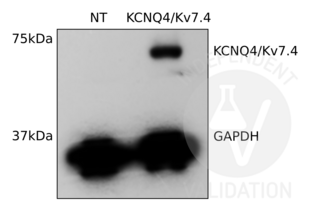KCNQ4 antibody (C-Term)
-
- Target See all KCNQ4 Antibodies
- KCNQ4 (Potassium Voltage-Gated Channel, KQT-Like Subfamily, Member 4 (KCNQ4))
-
Binding Specificity
- C-Term
-
Reactivity
- Human, Mouse
-
Host
- Rabbit
-
Clonality
- Polyclonal
-
Conjugate
- This KCNQ4 antibody is un-conjugated
-
Application
- Western Blotting (WB), ELISA
- Specificity
- KCNQ4 Polyclonal Antibody detects endogenous levels of KCNQ4 protein.
- Characteristics
- Rabbit Polyclonal to KCNQ4.
- Purification
- The antibody was affinity-purified from rabbit antiserum by affinity-chromatography using epitope-specific immunogen.
- Immunogen
- Synthesized peptide derived from the C-terminal region of human KCNQ4.
- Isotype
- IgG
-
-
- Application Notes
- WB 1:500-1:2000, ELISA 1:5000,
- Restrictions
- For Research Use only
-
- by
- Dipartimento di Medicina e Scienze della Salute, Università degli Studi del Molise, Campobasso
- No.
- #102194
- Date
- 04/11/2019
- Antigen
- Kv7.4/KCNQ4
- Lot Number
- 3824901
- Method validated
- Western Blotting
- Positive Control
NCHO cells non transfected or transfected with each other member of the Kv7 family (Kv7.1, Kv7.2, Kv7.3 or Kv7.5)
- Negative Control
Western blot analysis of KCNQ4/KV7.4 using ABIN3185286. Total lysates from non-transfected (NT) CHO cells or cells transfected with plasmids expressing human Kv7.4 (Kv7.4) cDNAs were prepared and separated as described in the protocol. GAPDH served as loading control.
- Notes
Passed. ABIN3185286 specifically detects KCNQ4/Kv7.4 in lysates from CHO cells expressing recombinant human KCNQ4/Kv7.4.
- Primary Antibody
- ABIN3185286
- Secondary Antibody
- goat anti-rabbit IgG (H+L) antibody (ImmunoReagents, GTXMU-003-DHRPX, lot 31-118-043013)
- Full Protocol
- Grow CHO cells (Chinese Hamster Ovary cells) in DMEM medium (Microgem, L0106-500) supplemented with 10% fetal bovine serum (Microgem, S1810-500) and 1x Penicillin-Streptomycin mix (Microgem, L0022-100), at 37°C and 5% CO2 in 60mm plates.
- Transfect CHO cells with plasmids expressing Kv7.4 with 5µg of plasmid each and 1µg of plasmid expressing EGFP as a transfection marker using Lipofectamine 2000 (invitrogen, 11668019) following the manufacturer´s instructions.
- Lyse cells in an appropriate volume of B-buffer, containing 150mM NaCl, 10mM Tris-HCl pH7.4, 1mM EDTA, 1% SDS and 1x protease inhibitors (Roche, 11836145001, lot 11231400).
- Determine total protein content of the lysates using a Bradford protein assay (AppliChem, A6932, lot 6J015116).
- Denature 20µg of total protein for 10min at 100°C in 1/3 volume of 4x Laemmli SDS sample buffer and subsequently separate them on a denaturing 8% SDS-PAGE gel in Mini-PROTEAN Electrophoresis Cells (Bio-Rad) for 2-3h at 100V.
- Transfer proteins onto PVDF filter (Bio-Rad, 1620177, lot 28369A01) with transfer buffer (25mM Tris, 192mM glycine, 20% methanol) in a western blotting system at 40mA at 4°C ON.
- Block the membrane with blocking buffer (PBS, 5% milk dissolved, 1% Tween20) for 1h at RT.
- Incubation with primary
- rabbit anti-KCNQ4/Kv7.4 antibody (antibodies-online, ABIN3185286, 3824901) diluted 1:500 in blocking buffer ON at 4°C or
- rabbit anti-GAPDH (abcam, ab1816002, lot GR217575-62) diluted 1:5000 in blocking buffer ON at 4°C.
- Wash membrane 3x for 10min with PBS-T.
- Incubation with secondary goat anti-rabbit IgG (H+L) antibody (ImmunoReagents, GTXMU-003-DHRPX, lot 31-118-043013) diluted 1:500 (for ABIN3185286) or 1:20000 (for anti-GAPDH) in blocking buffer for 1h at RT.
- Wash membrane 3x for 10min with PBS-T.
- Treat PVDF filters with chemiluminescence solutions (ECL, Promega) for 5min at RT then develop and acquire signals.
- Experimental Notes
Validation #102194 (Western Blotting)![Successfully validated 'Independent Validation' Badge]()
![Successfully validated 'Independent Validation' Badge]() Validation ImagesFull Methods
Validation ImagesFull Methods -
- Format
- Liquid
- Concentration
- 1 mg/mL
- Buffer
- Liquid in PBS containing 50 % glycerol, 0.5 % BSA and 0.02 % sodium azide.
- Preservative
- Sodium azide
- Precaution of Use
- This product contains Sodium azide: a POISONOUS AND HAZARDOUS SUBSTANCE which should be handled by trained staff only.
- Handling Advice
- Avoid repeated freeze/thaw cycles.
- Storage
- -20 °C
- Storage Comment
- Store at -20°C.
-
- Target
- KCNQ4 (Potassium Voltage-Gated Channel, KQT-Like Subfamily, Member 4 (KCNQ4))
- Alternative Name
- KCNQ4 (KCNQ4 Products)
- Synonyms
- KCNQ4 antibody, k(v)7.4 antibody, kv7.4 antibody, DFNA2 antibody, DFNA2A antibody, KV7.4 antibody, potassium voltage-gated channel subfamily Q member 4 antibody, potassium channel, voltage gated KQT-like subfamily Q, member 4 antibody, potassium voltage-gated channel, subfamily Q, member 4 antibody, KCNQ4 antibody, kcnq4 antibody, Kcnq4 antibody
- Molecular Weight
- 80 kDa
- Gene ID
- 9132
- UniProt
- P56696
- Pathways
- Sensory Perception of Sound
-


 (1 validation)
(1 validation)



